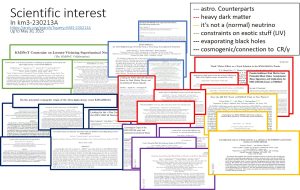14 June 2025 – It is about four months since we published our KM3-230213A event.
The unprecedented event was recorded in the middle of the night of 13 February 2023 in the ARCA detector. During a time window of almost 2 microseconds, more than 28,000 photons were recorded in the almost 12,000 photomultipliers of the detector. From the analysis of the data it was possible to identify a single charged particle, a muon, which had crossed the entire detector. Detailed studies led to an estimate of energy of the primary neutrino at the level of 220 PeV, significantly higher than any neutrino ever detected before.
On 12 February 2025 we reported the discovery of KM3-230213A in an on-line seminar and published a paper in Nature. In follow-up papers we discussed possible origins of the neutrino from KM3-230213A.
Since then the wider community of astroparticle physicists and astronomers have investigated multiple explanations for the extremely energetic neutrino. To date, they published in total more than 30 papers on the preprint server arXiv.
Could the KM3-230213A neutrino originate from a blazar or a year-long transient source? Or is there a radio counterpart? Can it be associated with gamma ray bursts? Others investigated the possibility that the neutrino was produced in the decay of dark matter or in an explosion of a black hole. Also, the possibility was investigated that the KM3-239213A neutrino is produced in the interaction of an ultra-energetic cosmic-ray particle with a photon of the background radiation that permeates the Universe.
Or could KM3-230213A point to new physics or to a violation of Lorentz invariance?
We are delighted that our discovery of the KM3-230213A event generated so much excitement in the scientific community.
You can find the preprints on arXiv with this search query:
https://arxiv.org/search/?query=KM3-230213A


